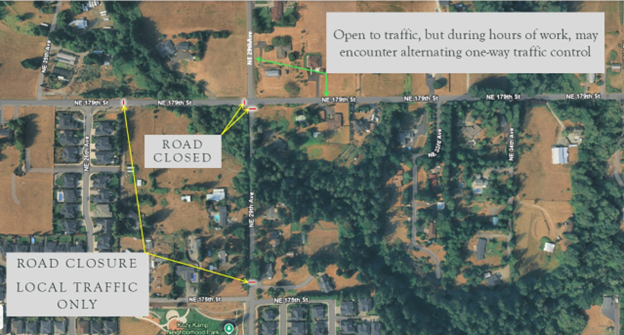Public Works is reconstructing the intersection of Northeast 179th Street and Northeast 29th Avenue. The existing single-lane, all-way stop-sign-controlled intersection will be replaced with a roundabout. This change is necessary to accommodate increasing traffic volumes associated with residential and commercial development in the area.

Construction and closure information
In late August, construction began on the Northeast 179th Street and Northeast 29th Avenue Intersection Improvement project. The first stage of road closures are now in effect as the contractor works on site clearing and preparation.
- Northeast 179th Street is closed west of the intersection, between Northeast 29th and 26th avenues.
- Northeast 29th Avenue is closed south of the intersection, between Northeast 179th and 175th streets.
Access to properties within the closure areas will be maintained.
A signed detour is in place to guide drivers around the closed areas.
*“Local access” refers to non-through traffic, i.e., traffic that is accessing a property located within the closed area.
During working hours (generally 7 a.m. to 3:30 p.m. Mondays through Fridays), travelers may encounter alternating one-way traffic control in some areas.
Construction is weather-dependent, and this closure is tentatively scheduled to be removed Dec. 1, 2025.
Page contents (click to jump to a section)
Project Timeline
Design: spring 2020 – spring 2025
Construction: summer 2025
The total budget identified for the project is $23.2 million, including a federal grant for approximately a third of the cost.
Click here to see the current project cost estimate.
Aug. 12 Informational Community Meeting
Thank you for joining us at the August 12 informational community meeting to learn more about the changes coming to the Northeast 179th Street and 29th Avenue Intersection.
Informational Community Meeting Handout (PDF)
Community Meeting Powerpoint (PDF)
Community Meeting Powerpoint - Español (PDF)
Community Meeting Powerpoint - Русский (PDF)
Community Meeting Powerpoint - Українська (PDF)
Mailers
August 2025 - Postcard (PDF)
April 2025 - Postcard (PDF)
June 2023 - Postcard (PDF)
January 2022- Heads Up (PDF)
August 2021 - Update Heads Up (PDF)
August 2021 Heads Up (PDF)
More information
Michael Tracy, project engineer
Clark County Public Works
564.397.4946
michael.tracy@clark.wa.gov